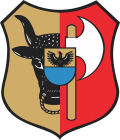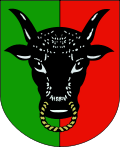Leszno
| Leszno | |||
|---|---|---|---|
|
Historic tenements on the main square | |||
| |||
|
Motto: "Leszno — rozwiń skrzydła" "Leszno — spread your wings" | |||
 Leszno | |||
| Coordinates: 51°51′N 16°34′E / 51.850°N 16.567°E | |||
| Country |
| ||
| Voivodeship |
| ||
| County | city county | ||
| Established | 14th century | ||
| Town rights | 1547 | ||
| Government | |||
| • Mayor | Łukasz Borowiak | ||
| Area | |||
| • Total | 31.9 km2 (12.3 sq mi) | ||
| Population (2014) | |||
| • Total | 64,612 | ||
| • Density | 2,000/km2 (5,200/sq mi) | ||
| Time zone | CET (UTC+1) | ||
| • Summer (DST) | CEST (UTC+2) | ||
| Postal code | 64-100 to 64-110 | ||
| Area code(s) | +48 065 | ||
| Car plates | PL | ||
| Website | www.leszno.pl | ||
Leszno [ˈlɛʂnɔ] (German: Lissa, between 1800 and 1918 also called Polnisch Lissa or Lissa in Posen) is a town in western Poland with 64,612 inhabitants (2014). Situated in the southern part of the Greater Poland Voivodeship since 1999, it was previously the capital of the Leszno Voivodeship (1975–1998). The town has county status.
History


The settlement probably arose in the 13th century. Leszno in the Polish Poznań Voivodeship was first mentioned in historical documents in 1393, when the estate was the property of Stefan z Karnina of Clan Wieniawa. The family adopted the surname of Leszczyński from the name of their estate according to the medieval custom of the Polish nobility.
Around 1516, a community of Protestant Unity of the Brethren refugees expelled from the Bohemian lands of King Vladislaus II settled in Leszno invited by the noble Leszczyński family, who were since 1473 Imperial counts and had converted to Calvinism. The arrival of the Bohemian Protestants as well as weavers from nearby Silesia helped the settlement to grow and made it possible to become a town in 1547 by a privilege according to Magdeburg Law given by King Sigismund I of Poland. Leszno was also the biggest printing center in Greater Poland thanks to the activity of the Protestant community, whose number increased because of inflow of refugees from Silesia, Bohemia and Moravia during the Thirty Years War. In 1631, Leszno was vested with further privileges by King Sigismund III Vasa, treating it as equal with the most important cities of Poland. At that time it already had a Gymnasium school led for a period by Jan Amos Komenský (known in English as Comenius) from Fulnek in Moravia, an educator who was a bishop of the Unity of the Brethren. From 1638 until his death in 1647, Johann Heermann, a German-speaking poet, lived in Leszno. Between 1636 and 1639, the town became fortified and its area increased.
The golden era of Leszno ended during the Second Northern War, when the town was burnt down on 28 April 1656. Quickly rebuilt afterwards, it was again set on fire during the Great Northern War by Russian forces in 1707 and was ravaged by a plague in 1709. The Leszczyński family owned the city until 1738 when King Stanisław Leszczyński sold it after he had abdicated for the second time.
During the Second Partition of Poland in 1793, Leszno was annexed by the Kingdom of Prussia and after the Napoleonic Wars was incorporated into the Grand Duchy of Posen as Lissa. In 1887 it became the administrative seat of the Prussian Kreis Lissa. The town took part in the Greater Poland Uprising of 1918–19 and was returned to the Second Polish Republic by the Treaty of Versailles with effect from 17 January 1920. The local populace had to acquire Polish citizenship. In the 1939 Invasion of Poland, the town was annexed by Nazi Germany and incorporated into Reichsgau Wartheland. The Polish population was resettled to the General Government. Most of the town's Jewish population (which in its history included such famous rabbis as Leo Baeck and Jacob of Lissa as well as the writer Ludwig Kalisch) and remaining Poles were murdered by the Nazi Einsatzgruppen.
After the defeat of Nazi-Germany, the town returned to Poland in 1945. It underwent a period of fast development especially between 1975 and 1998 when it was a seat of a voivodeship administrative area. In 2000 the city was awarded "The Golden Star of Town Twinning" prize by the European Commission.
International relations
Twin towns – Sister cities
Leszno is twinned with:
Sport
- Unia Leszno speedway club
The Leszno motorcycle club was founded on May 8, 1938. The club was re-established May 2, 1946 after World War II. On July 28, 1949 the Leszno motorcycle club changed its name to Unia Leszno Speedway Club. When the name was changed, some rules and regulations were changed as well. The Unia Leszno has been a very successful club that has won many awards and medals throughout the years. The Unia Leszno Speedway Club has won over 78 different medals since the formation of the club.
- Leszno Aero Club
The Leszno Aero Club is the largest airfield in the Wielkopolska area. The Aero Club belongs to the Polish Aero Club central gliding school. The Aero CLub in Leszno hosted the world gliding championship in 1958, 1969, and 2003. It is the only place that has done so. The Aero Club also has a pilot school called the Central Gliding school. The school has been around for over 50 years.
- KS Polonia Leszno
The Klub Sportowy Polonia Leszno was formed in 1912 in Leszno. It is an indoor soccer field. The first President of the club was Marcin Giera. The club did notgain much popularity until after World War II when official teams started playing there. Prior to World War I most of the people that played there were locals.
Museums
- Muzeum Okregowe
The Muzeum Okregowe in Leszno was founded in 1949. It officially opened on January 1, 1950. It is known to be own of the oldest museums in the Wielkopolska area of Poland. The museum displays Leszno's history and culture from the past 50 years. It specializes in artifacts from the 17th century. Throughout the years, things from the museum were moved to different museums around Poland. In early 1963 the artifacts were officially and permanently placed in an old pastors home. The building is located on No. 17 Metzig Square.
Primary schools
- Szkoła Podstawowa Nr 1
- Szkoła Podstawowa Nr 2
- Szkoła Podstawowa Nr 3
- Szkoła Podstawowa Nr 4
- Szkoła Podstawowa Nr 5
- Zespół Szkół Specjalnych Nr 6
- Szkoła Podstawowa Nr 7
- Szkoła Podstawowa Nr 8
- Szkoła Podstawowa Nr 9
- Szkoła Podstawowa Nr 10
- Szkoła Podstawowa Nr 12
- Szkoła Podstawowa Nr 13
Middle schools
- Gimnazjum Nr 1
- Gimnazjum Nr 2
- Gimnazjum Nr 3
- Gimnazjum Nr 4
- Gimnazjum Nr 5
- Zespół Szkół Specjalnych Nr 6
- Gimnazjum Nr 7 SP 13
- Gimnazjum Nr 8
- Gimnazjum Nr 9
Secondary schools
- Liceum Ogólnokształcące Nr 1 http://lo1.leszno.edu.pl/
- Liceum Ogólnokształcące Nr 2 http://www.iilo.leszno.pl/
- Liceum Ogólnokształcące Nr 3
- Liceum Ogólnokształcące Nr 4
Technical Schools
- Zespół Szkół Rolniczo-Budowlanych im. Synów Pułku
- Zespół Szkół Ekonomicznych im.Jana Amosa Komeńskiego
- Zespół Szkół Technicznych im. 55 Poznańskiego Pułku Piechoty http://www.zst-leszno.pl
- Zespół Szkół Elektroniczno-Telekomunikacyjnych
- Zespół Szkół Ochrony Środowiska
High schools
- Państwowa Wyższa Szkoła Zawodowa http://www.pwsz.edu.pl/
- Wyższa Szkoła Humanistyczna
- Wyższa Szkoła Marketingu i Zarządzania http://www.wsmiz.edu.pl/
- Nauczycielskie Kolegium Języków Obcych http://www.nkjoleszno.pl/
People
- Krzysztof Kasprzak Speedway Rider
- Haym Solomon (1740 – 1785), an important figure in the American Revolutionary War
- Jacob of Lissa, a rabbi
- Leser Landshuth (1817 - 1887), German Jewish liturgiologist
- Albert Mosse (1846 – 1925), German judge and legal scholar
- Zvi Hirsch Kalischer (1795 – 1874); Orthodox German rabbi
- Ludwig Kalisch (1814 - 1882), German-Jewish novelist
- Stephan Born (1824–1898), German revolutionary
- Carl Friedrich Richard Förster (1825–1902), German ophthalmologist
- Otto Schultzen (1837–1875), German physician
- Ottomar Anschütz (1846 – 1907), German inventor, photographer and chronophotographer
- Paul Cinquevalli (1859-1918), German-British artist
- Albert Moll (1862 – 1939) German psychiatrist
- Leo Baeck (1873 – 1956), German-Jewish rabbi
- Rudolf Leonhard (1889-1953), German author and communist activist
- Wolfgang Martini (1891-1963), German general
- Ludwig Schulz (1896–1966), Luftwaffe general
- Gerhard Weisser (1898-1989) German social scientist
- Johannes Eisermann (1900 – 1976), Wehrmacht officer
- Wolfgang Thomale (1900-1978), German general
- Antoni Janusz (1902-2000), Polish sportsman and pilot
- Ilse Schwidetzky (1907-1997), German anthropologist
- Stanisław Grochowiak (1934-1976)
- Peter Lindbergh (born 1944), German photographer and director
- Rafał Dobrucki Speedway Rider
- Alexandria Riordan
References
External links
| Wikimedia Commons has media related to Leszno. |
Coordinates: 51°52′N 16°34′E / 51.867°N 16.567°E
.jpg)



